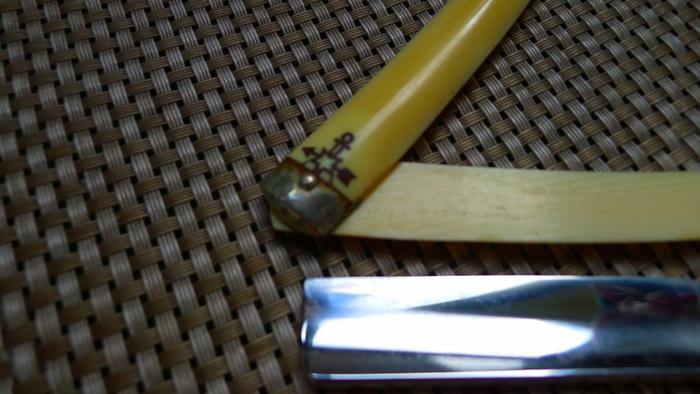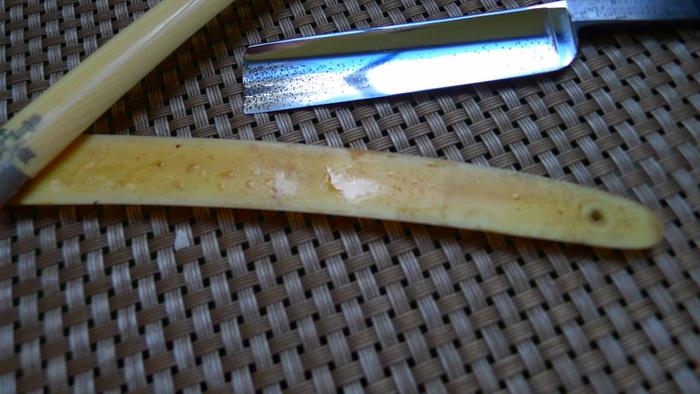Results 21 to 30 of 52
Thread: Classic example of Celluloid Rot
-
09-08-2016, 06:22 PM #21

I seem to recall that someone posted the worst offenders are the clear scales. They can be kinda obvious as they turn to amber when rotting. Ran away from some cheap dubl duck auctions because of that.
-
09-08-2016, 06:41 PM #22

((Spoken in a thick accent)) Veerryy, Very Interesting!
One interesting thing is, "...Thermal degradation of celluloid involves the breaking off of nitrate groups in the cellulose nitrate molecule. As a result, nitrous gases are evolved...." If I could figure a way out to double the nitrite OR 1/2 the oxygen, that's Laughing Gas! Also, "Go fast juice' for us Hot-Rodders!
Also, "Go fast juice' for us Hot-Rodders! 
On a serious note, however. "...Light, alkalis, acids, and certain metallic oxides can be very detrimental. The primary environmental contributor to celluloid degradation, however, appears to be moisture...." This is pretty much everything we use during shaving, including the lye base in our soaps.
-
09-08-2016, 06:46 PM #23

The little bit more reading I done online (and of course, it HAS to be true if it's on the internet ;-) ), degradation is caused by the release of Camphor molecules. Camphor is white or clear and is one of the main ingredients in making celluloid parts.
So, this make perfect sense dinnermint!
-
09-08-2016, 07:43 PM #24

Okay - I got what it is. So, looking at a set of scales, how can you tell whether or not the process has started?
Semper Fi !
John
-
09-08-2016, 08:22 PM #25

"...Cellulose nitrate is affected by light and moisture and releases potentially dangerous chemicals during degradation. Do not store items made from this material in plastic bags or other packaging with restricted ventilation. Early signs of breakdown include a smell of camphor, disintegration of wrapping tissue, surface bloom and yellowing..."
-
09-09-2016, 12:09 AM #26

The way I noticed on two different occasions was by a light line of spotty rust on the blade. This led me to inspect the inside of the scales. I could see 'stuff' puddling up on the inside. Here are pix I posted in another thread at the time of the first victim.


Note the freckled appearance/pattern of rust on the end of the blade in the second pic. That is typical of cell rot IME. That 'stuff' on the scales in the bottom pic is wet even though the razor was stored dry in a closed drawer.Be careful how you treat people on your way up, you may meet them again on your way back down.
-
The Following 5 Users Say Thank You to JimmyHAD For This Useful Post:
32t (09-09-2016), cudarunner (09-09-2016), Geezer (09-28-2016), Johntoad57 (09-09-2016), Prahston (09-09-2016)
-
09-09-2016, 12:25 AM #27

I have quite a few vintage razors...some with celluloid scales...and I keep them in an airtight tote box with gel packs. Now I am concerned this may not be the best way to store my SRs. If one set of scales starts developing cell rot will it spread through the other SRs in the tote box?
-
09-09-2016, 12:28 AM #28
-
09-09-2016, 12:37 AM #29Who's that guy think he is...


- Join Date
- Jun 2011
- Location
- The North Coast, Ohio
- Posts
- 2,455
Thanked: 146
Just recently found a case of this on one of my favorites, the 'cracked ice ' scales are supposed to be prone to this, unpinned and put the scales in the toolbox out in the garage. Far far away from all else. This sucks, but at least I caught it early. ..
 Luck is a matter of preparation meeting opportunity. ~Lucius Annaeus Seneca
Luck is a matter of preparation meeting opportunity. ~Lucius Annaeus Seneca
-
09-09-2016, 12:40 AM #30

When I did this project I specifically asked my friend Ski to make sure that there were ventilation slots in the display box as the razor IS in celluloid scales.
http://straightrazorpalace.com/razor...forgotten.htmlOur house is as Neil left it- an Aladdins cave of 'stuff'.
Kim X


 60Likes
60Likes LinkBack URL
LinkBack URL About LinkBacks
About LinkBacks






 Reply With Quote
Reply With Quote






